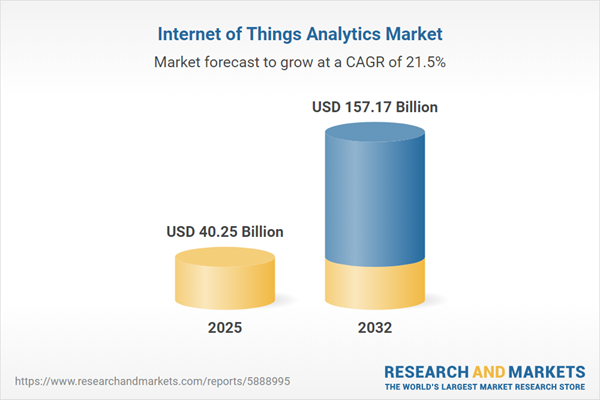Speak directly to the analyst to clarify any post sales queries you may have.
The Internet of Things analytics market is transforming operational strategies across industries, making connected data actionable for organizations seeking to improve efficiency, resilience, and competitiveness at scale.
Market Snapshot: Internet of Things Analytics Market Growth
The Internet of Things analytics market grew from USD 33.18 billion in 2024 to USD 40.25 billion in 2025. It is expected to continue expanding at a CAGR of 21.46%, reaching USD 157.17 billion by 2032.
This rapid growth is fueled by the proliferation of connected devices, heightened digital transformation, and increasing demand for real-time data-driven insights in globally distributed operations.Scope & Segmentation of the IoT Analytics Market
This report examines emerging trends and actionable opportunities in the Internet of Things analytics market. Key segmentation includes:
- End Use Industry: Energy & Utilities, Healthcare (Hospital, Pharmaceuticals), Manufacturing (Discrete Manufacturing, Process Manufacturing), Retail (Brick and Mortar, Online Retail), Transportation & Logistics (Aviation, Maritime, Rail Transportation, Road Transportation)
- Analytics Type: Descriptive, Diagnostic, Predictive, Prescriptive
- Deployment Mode: Cloud, On Premises
- Organization Size: Large Enterprises, SMEs
- Regions Covered: Americas (North America: United States, Canada, Mexico; Latin America: Brazil, Argentina, Chile, Colombia, Peru), Europe, Middle East & Africa (United Kingdom, Germany, France, Russia, Italy, Spain, Netherlands, Sweden, Poland, Switzerland, United Arab Emirates, Saudi Arabia, Qatar, Turkey, Israel, South Africa, Nigeria, Egypt, Kenya), Asia-Pacific (China, India, Japan, Australia, South Korea, Indonesia, Thailand, Malaysia, Singapore, Taiwan)
- Key Technologies: Edge computing, advanced machine learning, anomaly detection, integrated platforms, cloud-native architectures
- Companies Profiled: Amazon.com, Inc., Microsoft Corporation, International Business Machines Corporation, Alphabet Inc., Cisco Systems, Inc., SAP SE, PTC Inc., Oracle Corporation, Software AG, Hitachi, Ltd.
Key Takeaways for Senior Decision-Makers
- Organizations across energy, healthcare, manufacturing, retail, and logistics are leveraging IoT analytics to enhance asset performance, streamline operations, and personalize services.
- Adoption follows a maturity curve, advancing from descriptive reporting to predictive and prescriptive analytics, indicating increasing utilization of AI-driven optimization and risk mitigation tools.
- Cloud-native deployments are favored for scalability and ease of integration, while on-premises solutions address stringent regulatory or latency requirements in sensitive sectors.
- Industry leaders pursue innovation through proprietary platforms, strategic alliances, and acquisition of analytics startups to strengthen capability portfolios.
- Regional strategies reflect localized challenges—from data privacy compliance in Europe to smart city investments in Asia-Pacific—necessitating adaptive business models and flexible architectures.
- The vendor ecosystem increasingly values open APIs and collaborative platforms, allowing seamless interoperability with existing operational technology.
Tariff Impact: Strategic Responses to US Policy Changes
The introduction of new US tariffs in 2025 has disrupted IoT analytics supply chains, increasing hardware procurement costs and prompting reevaluation of sourcing and manufacturing strategies. In response, solution providers are expanding regional operations and diversifying trade agreements to limit risk exposure. Pricing structures have become more flexible, with businesses focusing on optimizing total cost of ownership and prioritizing outcome-based analytics solutions. This evolving landscape is expected to drive greater vendor vertical integration and increased investment in open-standard hardware, supporting ongoing market momentum.
Methodology & Data Sources
This report synthesizes qualitative and quantitative analyses, drawing on technical white papers, regulatory filings, industry studies, expert interviews, case studies, and scenario modeling. Data accuracy is ensured by triangulating vendor metrics, cross-validating findings, and engaging independent peer reviewers throughout the research process.
Why This Report Matters
- Gain comprehensive insight into current and emerging IoT analytics market drivers, risk factors, and barriers to adoption across multiple industry verticals.
- Identify actionable strategies to strengthen resilience amid new trade policies, changing regulatory frameworks, and regional infrastructure trends.
- Leverage deep segmentation to benchmark competitive intelligence, innovation portfolios, and strategic partnership models across the IoT analytics landscape.
Conclusion
The Internet of Things analytics market is undergoing rapid transformation as organizations integrate data-driven intelligence across core functions. Strategic technology adoption, flexible deployment, and collaborative ecosystems will define future leadership in this evolving space.
Additional Product Information:
- Purchase of this report includes 1 year online access with quarterly updates.
- This report can be updated on request. Please contact our Customer Experience team using the Ask a Question widget on our website.
Table of Contents
3. Executive Summary
4. Market Overview
7. Cumulative Impact of Artificial Intelligence 2025
Companies Mentioned
The companies profiled in this Internet of Things Analytics market report include:- Amazon.com, Inc.
- Microsoft Corporation
- International Business Machines Corporation
- Alphabet Inc.
- Cisco Systems, Inc.
- SAP SE
- PTC Inc.
- Oracle Corporation
- Software AG
- Hitachi, Ltd.
Table Information
| Report Attribute | Details |
|---|---|
| No. of Pages | 183 |
| Published | November 2025 |
| Forecast Period | 2025 - 2032 |
| Estimated Market Value ( USD | $ 40.25 Billion |
| Forecasted Market Value ( USD | $ 157.17 Billion |
| Compound Annual Growth Rate | 21.4% |
| Regions Covered | Global |
| No. of Companies Mentioned | 11 |









